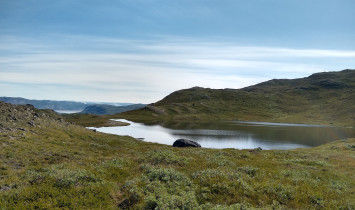Greenhouse gases
Reducing greenhouse gas emissions
Too much greenhouse gas in the atmosphere contributes to global warming. Part of the solution is to control soil and water systems so that they emit fewer and absorb more greenhouse gases. Researchers at NIOO try to understand the biological processes that make this possible. To contribute with fundamental knowledge to concrete action perspectives, for farmers and governments.
Microbial ecologists at NIOO study how soil organisms in agriculture can contribute to storing carbon in the soil on the one hand and emit less nitrogen on the other, while yields for farmers remain the same. The microbial ecologists work intensively with stakeholders, such as plant breeders, governments and other knowledge institutions.
The microbes that I study, consume methane and thereby they contribute to the reduction of emissions. In addition, we also study how we can reduce nitrous oxide emissions by steering the soil microbes.
Methane-eating bacteria
Paul Bodelier specialises in the degradation of methane by microbes. "Microorganisms in the soil can naturally use methane for energy generation and as a source of carbon to make new cells. Agricultural soils are less able to break down methane microbially. By adding ‘green’ compost with micro-organisms that specialise on utilising low concentrations of methane, we want to restore that soil function. We focus on the mechanisms, asking questions such as: "Which organisms are involved and what properties are important to steer these functions?"
Thus, in such green compost, Bodelier's research group discovered bacteria that are specialised in taking up methane from the atmosphere and become dominant in agricultural soils after long-term addition, which is an example of steering the microbiome.
Mitigating nitrogen emissions in agriculture
Bodelier's colleague Eiko Kuramae is concerned with reducing nitrogen emissions in agriculture. "Nitrogen emissions are a direct result of fertilisation. Approximately 70% of the inorganic nitrogen added to the agricultural system is lost in water and air. Inorganic nitrogen is converted into nitrous oxide - N2O - by soil bacteria and archaea in a process called nitrification, and disappears into the air."
Kuramae’s main interest is to understand the microbial processes in producing nitrous oxide in soil, especially in agriculture. In a research project on the emission of N2O in sugarcane production in Brazil, Kuramae discovered that nitrification by soil bacteria is the main microbial process responsible for the loss of nitrogen into the air. By understanding this mechanism, her team introduced management practices. Kuramae: “The approach aims to slow down the activities of the soil microbes responsible for N2O emissions while maintaining the same crop productivity. This sugarcane management production practice has been implemented as policy for sustainable sugarcane production in Brazil. Farmers now use significantly less inorganic nitrogen, and recycle organic residues as nutrient sources.”
Kuramae also focuses her research on understanding the interaction between plants and soil microbes in producing nitrous oxide. Some plants naturally release exudates through their roots that can inhibit the nitrification by bacteria. These so-called Biological Inhibitors of Nitrification (BNI) are found for instance in grasses, sugarcane, rice, sorghum, maize and cover crops. Kuramae: “Understanding what compounds are produced by these plants can pave the way to cultivate plants with high capacity to inhibit the activity of microbes that convert nitrogen to N2O and thus reduce the emissions of nitrous oxide in agriculture at large.”
The management production practice to slow down the soil microbes responsible for emitting N2O has been implemented as policy for sustainable sugarcane production in Brazil.
Calculating emissions from water
Researchers from the Aquatic Ecology department are also working on the uptake and emissions of the same greenhouse gases methane and nitrous oxide, but from freshwater systems. "Only for a short while now, there is an international obligation to calculate emissions from freshwater in addition to emissions from agriculture and industry," explains aquatic ecologist Sven Teurlincx. "As a result, research into this has accelerated relatively recently."
NIOO's aquatic ecologists model ecosystems to see what the differences in emissions are from different types of lakes and ditches in the Netherlands. Teurlincx: "A shallow ditch captures carbon very differently than a deep lake. The influence of changing conditions is also important, such as climate change or changing management. Especially with management, you can exert a lot of influence on a system: mowing, dredging and flushing lakes affect the amount of organic matter and oxygen in the water. Those two factors largely determine which and how much greenhouse gases a freshwater system emits."
Only for a short while now, there is an international obligation to calculate emissions from freshwater in addition to emissions from agriculture and industry.
Preventing methane production
In water, the main issue is to prevent the production of methane instead of carbon dioxide. Teurlincx: "Under oxygen-rich conditions in freshwater, carbon dioxide is the product of the breakdown of organic material. By contrast, where oxygen is depleted, the microorganisms use a different method of decomposition and methane is eventually produced, which rises and is released into the air."
The aim, therefore, is to prevent a system from becoming deoxygenated. "The main condition for this is to not get too much organic material into the system, for example by dying plants," Teurlincx explains. “An excess of nutrients in the water, washing out from agriculture or a sewer, creates an unstable water ecosystem, which can easily become a source of greenhouse gas."
Experts
-
Paul Bodelier
Senior Researcher , Microbial Ecology
-
Eiko Kuramae
Senior Researcher , Microbial Ecology
-
Sven Teurlincx
Project Manager | Researcher , AKWA (Aquatic Knowledge Centre Wageningen) | Aquatic Ecology
-
Lisette de Senerpont Domis
Senior Researcher , AKWA (Aquatic Knowledge Centre Wageningen) | Aquatic Ecology
-
Suzanne McGowan
Head of department , Aquatic Ecology
Applications
- Soil management
- Water management
- Environmental policy
- Natural and agriculture land use




